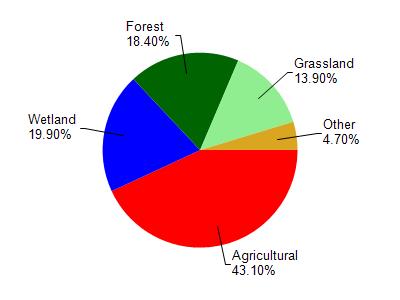Columbia
No
No
No
Fish and Aquatic Life
Overview
Lake Columbia is the manmade cooling impoundment of the Columbia Generating Station. It
was constructed by building a dike around 500 acres of wetlands adjacent to the Wisconsin
River in the 1970s. The plant went on line in 1977. A lake depth of seven feet is fairly
uniform throughout. A center dike allows water to circulate around the lake from the hot
discharge to the cooler intake. Typically there is a 25 F degree difference between the
discharge and intake with 15-20 F degree dissipation occurring on the hot side of the lake.
Cooling towers operate during summer months and/or when power generation heats the lake
intake above a certain temperature. Water loss from evaporation and seepage through the
dike requires make-up water to be pumped into the lake from the Wisconsin River. The hot
water creates a harsh aquatic environment. Entire lake temperatures from May - November
exceed 90 F degrees. Aquatic vegetation, which typically supports aquatic invertebrates,
which in turn provide forage for fish, cannot survive these extreme temperatures. Fish species
which have adapted to this environment are large and smallmouth bass, bluegill, bullheads,
channel catfish and gizzard shad. Many of the smaller fish are in poor condition. When the
predator species become larger, i.e. bass greater than 14 inches and catfish greater than 16
inches, they can utilize the larger gizzard shad and gain weight. Hybrid striped bass (white
bass X striped bass) are stocked to provide a unique fishery and control the shad population.
Since the lake doesn
**18**
t freeze, it provides anglers with an open water fishing opportunity
throughout the winter. The lake receives treated discharges of domestic sewerage from the
power plant and the acidic runoff from the coal pile.
Date 2002
Author Aquatic Biologist
Condition
Wisconsin has over 84,000 miles of streams, 15,000 lakes and milllions of acres of wetlands. Assessing the condition of this vast amount of water is challenging. The state's water monitoring program uses a media-based, cross-program approach to analyze water condition. An updated monitoring strategy (2015-2020) is now available. Compliance with Clean Water Act fishable, swimmable standards are located in the Executive Summary of Water Condition in 2018. See also the 'monitoring and projects' tab.
Reports
Management Goals
Wisconsin's Water Quality Standards provide qualitative and quantitative goals for waters that are protective of Fishable, Swimmable conditions [Learn more]. Waters that do not meet water quality standards are considered impaired and restoration actions are planned and carried out until the water is once again fishable and swimmable
Management goals can include creation or implementation of a Total Maximum Daily Load analysis, a Nine Key Element Plan, or other restoration work, education and outreach and more. If specific recommendations exist for this water, they will be displayed below online.
Monitoring
Monitoring the condition of a river, stream, or lake includes gathering physical, chemical, biological, and habitat data. Comprehensive studies often gather all these parameters in great detail, while lighter assessment events will involve sampling physical, chemical and biological data such as macroinvertebrates. Aquatic macroinvertebrates and fish communities integrate watershed or catchment condition, providing great insight into overall ecosystem health. Chemical and habitat parameters tell researchers more about human induced problems including contaminated runoff, point source dischargers, or habitat issues that foster or limit the potential of aquatic communities to thrive in a given area. Wisconsin's Water Monitoring Strategy was recenty updated.
Grants and Management Projects
| Project Name (Click for Details) | Year Started |
|---|
|
|
Monitoring Projects
| WBIC | Official Waterbody Name | Station ID | Station Name | Earliest Fieldwork Date | Latest Fieldwork Date | View Station | View Data |
|---|
| 977600 | Lake Columbia | 113054 | Wisconsin River - Wis Power And Light Columbia 001 | 8/17/1977 | 9/17/1980 | Map | Data |
| 977600 | Lake Columbia | 10001147 | Lake Columbia | 7/27/1999 | 9/30/2017 | Map | Data |
| 977600 | Lake Columbia | 10021447 | Columbia Lake - Center | 6/9/2007 | 8/26/2007 | Map | Data |
|

Watershed Characteristics
Lake Columbia is located in the Duck Creek and Rocky Run watershed which is 140.89 mi². Land use in the watershed is primarily agricultural (43.10%), wetland (19.90%) and a mix of forest (18.40%) and other uses (18.60%). This watershed has 232.25 stream miles, 1,895.92 lake acres and 16,023.66 wetland acres.
Nonpoint Source Characteristics
This watershed is ranked Medium for runoff impacts on streams, Low for runoff impacts on lakes and High for runoff impacts on groundwater and therefore has an overall rank of High. This value can be used in ranking the watershed or individual waterbodies for grant funding under state and county programs.However, all waters are affected by diffuse pollutant sources regardless of initial water quality. Applications for specific runoff projects under state or county grant programs may be pursued. For more information, go to surface water program grants.